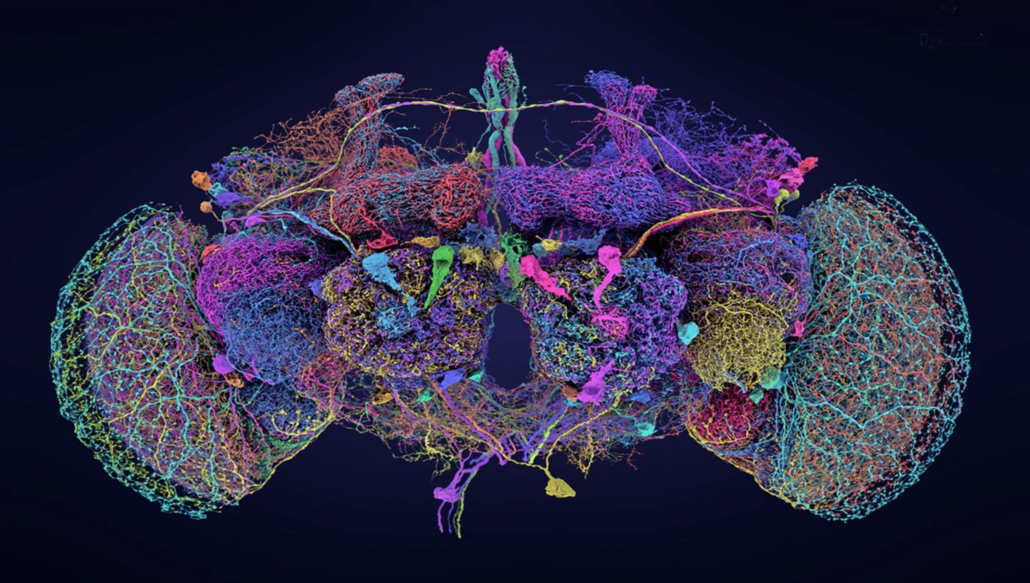Unveiling the neural labyrinth: Fruit fly brain map sets new benchmark in neuroscience
Researchers unveil the most comprehensive neural map of an adult animal brain to date, offering unprecedented insights into brain circuitry and function.

Researchers have mapped nearly 140,000 neurons in the fruit-fly brain. This version shows the 50 largest.
©Tyler Sloan and Amy Sterling for FlyWire, Princeton University
In a significant advancement for neuroscience, researchers have successfully mapped nearly 140,000 neurons in the brain of a common fruit fly, creating the largest and most complete connectome of an adult animal to date. This groundbreaking work, supported by the U.S. National Institutes of Health (NIH), provides a detailed wiring diagram of the fruit fly brain, offering crucial information about neural connections and signalling pathways underlying healthy brain function. The study, along with eight companion papers, was published in the journal Nature on 2 October 2024.
The scope of the project
The fruit fly connectome project, a collaboration involving scientists worldwide, has produced a neural map of extraordinary detail and complexity. The connectome includes over 50 million connections between more than 130,000 neurons, providing an unprecedented level of insight into the structure and organisation of the fruit fly brain.
Dr John Ngai, director of NIH’s Brain Research Through Advancing Innovative Neurotechnologies Initiative (The BRAIN Initiative), emphasised the significance of this achievement: “The diminutive fruit fly is surprisingly sophisticated and has long served as a powerful model for understanding the biological underpinnings of behaviour. This milestone not only provides researchers a new set of tools for understanding how the circuits in the brain drive behaviour, but importantly serves as a forerunner to ongoing BRAIN-funded efforts to map the connections of larger mammalian and human brains.”
Methodology and collaboration
The creation of this comprehensive brain map involved a multi-step process combining advanced imaging techniques, artificial intelligence, and human expertise. Researchers began with electron microscope images of the complete fly brain, which had been previously released to the public. A computer program was then used to automatically identify and segment the neurons in these images.
Recognising the potential for errors in automated segmentation, the research team developed a computational system that allowed a large online research community to review the segments, proofread them for accuracy, and annotate cell types and classes. This community-driven approach, facilitated by a consortium of fruit fly labs called FlyWire, significantly accelerated the completion of the connectome.
Dr Shelli Avenevoli, acting director of NIH’s National Institute of Mental Health, noted the impact of this collaborative effort: “In 2021, only 15% of the neurons had been proofread. Opening proofreading to the larger scientific community studying the fruit fly brain greatly accelerated how fast we were able to complete this connectome.”
Key findings and implications
The fruit fly connectome provides detailed information on the full set of cell classes in the fruit fly brain, identifying different types of neurons and the chemical connections, or synapses, between them. It also offers insight into the types of neurotransmitters secreted by each neuron, such as dopamine or serotonin.
In addition to the connectome, the researchers created a map of projections between brain regions, known as a projectome. This map tracks the organisation of the hemispheres and behavioural circuits within the fly brain, allowing for detailed mapping of specific brain circuits that control behaviour. For example, the ocellar brain circuit, which processes visual stimuli and outputs behavioural changes that orient the fly’s body during flight, can now be studied in unprecedented detail.
The choice of the fruit fly as a model organism for this project was strategic. Despite its small size, the fruit fly is capable of surprisingly advanced cognition and behaviour, including forming long-term memories, engaging in social interactions, and navigating over large distances. This makes it an ideal candidate for initial connectome studies, with the potential to inform our understanding of more complex brains.
Future directions and applications
The completion of the fruit fly connectome marks a significant milestone in neuroscience, but it also opens up new avenues for research. The methodology developed for this project could be applied to create similar maps in larger-brained animals, potentially accelerating our understanding of more complex neural systems.
Moreover, the fruit fly connectome may serve as a reference to understand how various human mutations affect brain connections. This could have far-reaching implications for the study of neurological and psychiatric disorders.
The research team has made the data analysis tools for the full fruit fly connectome publicly available, encouraging further exploration and collaboration within the scientific community. As researchers begin to utilise this wealth of information, it is expected that new insights into brain function, behaviour, and the underlying mechanisms of neurological disorders will emerge.
References:
Dorkenwald, S., Matsliah, A., Sterling, A. R., et. al. (2024). Neuronal wiring diagram of an adult brain. Nature. https://doi.org/10.1038/s41586-024-07558-y
The FlyWire Connectome: https://www.nature.com/immersive/d42859-024-00053-4/index.html

